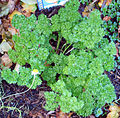Biennial plant
Biennial plants are a distinct group of plants within the plant kingdom that complete their life cycle over two years. This life cycle is characterized by two main phases: a vegetative phase during the first year and a reproductive phase in the second year. During the first year, biennial plants grow leaves, stems, and roots, typically forming a rosette at the ground level. In the second year, they use the stored nutrients to produce flowers, seeds, and then die. This two-year strategy is distinct from annual plants, which complete their life cycle in one year, and perennial plants, which live for more than two years.
Life Cycle[edit]
The life cycle of biennial plants can be divided into two stages: the vegetative stage and the reproductive stage. During the first year, or the vegetative stage, biennials focus on growth and accumulation of nutrients in their leaves and roots. This stage is crucial for the survival and reproductive success of the plant in its second year. In the second year, the plant enters the reproductive stage, where it diverts its stored energy towards flowering, fruiting, and seeding. After seed dispersal, the biennial plant completes its life cycle and dies.
Examples[edit]
Common examples of biennial plants include Carrot (Daucus carota), Parsley (Petroselinum crispum), and Common mullein (Verbascum thapsus). These plants are often of significant agricultural and ecological importance, providing food, spices, and habitat for various species.
Cultivation[edit]
Biennial plants require specific cultivation practices to ensure their growth and development. During the first year, it is important to provide them with adequate water, sunlight, and nutrients to establish a strong vegetative base. In the second year, as the plants prepare to flower and set seed, gardeners may need to adjust their care to support these processes. Understanding the biennial nature of these plants is crucial for effective garden planning and crop rotation.
Ecological Significance[edit]
Biennial plants play a unique role in their ecosystems. They often act as pioneer species, colonizing disturbed soils and providing ground cover that reduces erosion. Their flowers are important for pollinators, and their seeds serve as food for various animals. The biennial life cycle allows these plants to take advantage of temporal niches in their environment, flowering at times when competition for pollinators is reduced.
Challenges[edit]
One of the main challenges in growing biennial plants is the requirement for overwintering, which can be difficult in colder climates. Additionally, because they do not flower until the second year, biennials can be mistakenly removed from gardens or overlooked in agricultural settings.
Conclusion[edit]
Biennial plants, with their unique two-year life cycle, contribute significantly to the biodiversity of plant life. Their cultivation and preservation are important for ecological balance, agricultural diversity, and the beauty of natural and designed landscapes.
-
Parsley Curled
-
Spring Flowers
Ad. Transform your life with W8MD's Budget GLP-1 injections from $75


W8MD offers a medical weight loss program to lose weight in Philadelphia. Our physician-supervised medical weight loss provides:
- Weight loss injections in NYC (generic and brand names):
- Zepbound / Mounjaro, Wegovy / Ozempic, Saxenda
- Most insurances accepted or discounted self-pay rates. We will obtain insurance prior authorizations if needed.
- Generic GLP1 weight loss injections from $75 for the starting dose.
- Also offer prescription weight loss medications including Phentermine, Qsymia, Diethylpropion, Contrave etc.
NYC weight loss doctor appointmentsNYC weight loss doctor appointments
Start your NYC weight loss journey today at our NYC medical weight loss and Philadelphia medical weight loss clinics.
- Call 718-946-5500 to lose weight in NYC or for medical weight loss in Philadelphia 215-676-2334.
- Tags:NYC medical weight loss, Philadelphia lose weight Zepbound NYC, Budget GLP1 weight loss injections, Wegovy Philadelphia, Wegovy NYC, Philadelphia medical weight loss, Brookly weight loss and Wegovy NYC
|
WikiMD's Wellness Encyclopedia |
| Let Food Be Thy Medicine Medicine Thy Food - Hippocrates |
Medical Disclaimer: WikiMD is not a substitute for professional medical advice. The information on WikiMD is provided as an information resource only, may be incorrect, outdated or misleading, and is not to be used or relied on for any diagnostic or treatment purposes. Please consult your health care provider before making any healthcare decisions or for guidance about a specific medical condition. WikiMD expressly disclaims responsibility, and shall have no liability, for any damages, loss, injury, or liability whatsoever suffered as a result of your reliance on the information contained in this site. By visiting this site you agree to the foregoing terms and conditions, which may from time to time be changed or supplemented by WikiMD. If you do not agree to the foregoing terms and conditions, you should not enter or use this site. See full disclaimer.
Credits:Most images are courtesy of Wikimedia commons, and templates, categories Wikipedia, licensed under CC BY SA or similar.
Translate this page: - East Asian
中文,
日本,
한국어,
South Asian
हिन्दी,
தமிழ்,
తెలుగు,
Urdu,
ಕನ್ನಡ,
Southeast Asian
Indonesian,
Vietnamese,
Thai,
မြန်မာဘာသာ,
বাংলা
European
español,
Deutsch,
français,
Greek,
português do Brasil,
polski,
română,
русский,
Nederlands,
norsk,
svenska,
suomi,
Italian
Middle Eastern & African
عربى,
Turkish,
Persian,
Hebrew,
Afrikaans,
isiZulu,
Kiswahili,
Other
Bulgarian,
Hungarian,
Czech,
Swedish,
മലയാളം,
मराठी,
ਪੰਜਾਬੀ,
ગુજરાતી,
Portuguese,
Ukrainian


